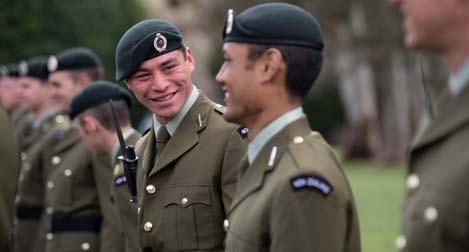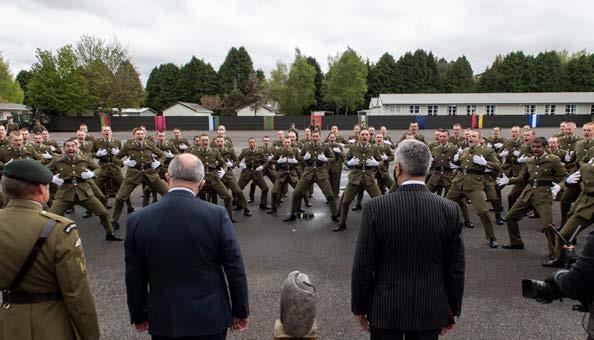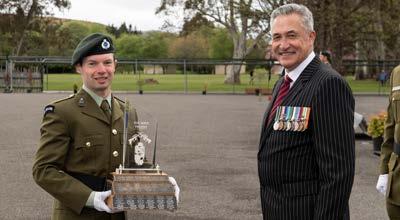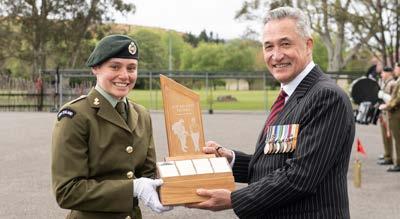
12 minute read
Our newest soldiers
MARCH OUT
RRF 403 & RRF 404
Advertisement
The Army’s newest soldiers marched out in Waiouru recently. Because of Covid-19 restrictions families and friends could not attend, but the graduations were live streamed to capture every minute of the important events.




The Chief of Army, Major General John Boswell reviewed Graduation 403.



403 Graduation Awards
Top Shot PTE Dale Jacobs, RNZIR Top Warrior PTE Blake McKay, RNZIR Top Recruit Elliott VC TPR Reagan Aylward, RNZAC Top Recruit Ngarimu VC TPR Anton Harrison, RNZAC Top Recruit PTE Jacobs, RNZIR Top Instructor BDR Ben Liua’ana, RNZA










Te Puni Kōkiri Chief Executive Lieutenant Colonel (Rtd) Dave Samuels reviewed Graduation 404.



404 Graduation Awards
Top Shot PTE Henry Scales, RNZMP Top Warrior SPR William Roberts, RNZE Brown VC Top Recruit SPR Wallace
Crichton VC Top Recruit SPR Minardi Daniel, RNZE Forsyth VC Top Recruit SPR Blanchet
SMA Award
SIG Taliah Pham, RNZSigs Top Recruit SPR Minardi Daniel, RNZE Top Instructor CPL Dan Millar, RNZIR





Rongomarae Roa o Ngā Hau e Whā New Zealand Army National Marae reopens
Two unique pouwhenua were unveiled on the grounds of Rongomarae Roa o Ngā Hau e Whā, New Zealand’s National Army Marae at a ceremony in November.


Dignitaries and soldiers gathered on the marae as dawn broke and watched as the stately pouwhenua were blessed.
The pouwhenua, carved by cousins Ted and Kurt Barham of Makakahi Enterprises were carved out of trees on the marae grounds that were dying and had become dangerous.
They were unveiled by the Chief of Army Major General John Boswell, along with the oldest and youngest soldiers of Ngāti Tūmatauenga – Mr Robert (Bom) Gillies who is the last surviving member of 28 Māori Battalion, and Recruit Gareth Komene who was the youngest recruit undergoing Basic Training.
Rongomarae Roa o Ngā Hau e Whā is the spiritual home of Ngāti Tūmatauenga, and all new recruits are welcomed on to the marae, and in to Ngāti Tūmatauenga during their basic or initial officer training.
MAJGEN Boswell told those gathered the unveiling was a celebration. “Firstly we celebrate the reopening of this very special Marae, the New Zealand Army National Marae, which has undergone some significant renovation to bring it up to code, and to refresh it, so that it can continue to play a critical role in the life of Ngāti Tūmatauenga.
“These carvings, He Hoia and He Toa are magnificent. Today we are also celebrating the signing of a Memorandum of Understanding between the New Zealand Army and Awanuiārangi, whose assistance will help the New Zealand Army, not only live, but progress our culture of Ngāti Tūmatauenga.”
Rongomaraeroa O Ngā Hau E Whā was established 25 years ago at the instigation of the then-Chief of Defence, the late LieutenantGeneral Tony Birks. On the outskirts of the Waiouru Military Camp, the marae is the spiritual home of Ngāti Tūmatauenga, the name granted to the Army by Māoridom in 1994.
TRADOC Commander Colonel Trevor Walker said the Memorandum of Understanding between Wānanga te Whare o Awanuiārangi and the New Zealand Army was another firm step towards realising the vision of a succession of Chiefs of Army, from General Birks to General Boswell whose support of Te Kura o Tūmatauenga would create an Army School, whose mission will be creating the cradle of education and support to strengthen the culture of Ngāti Tūmatauenga.
“The mission of Te Kura o Tūmatauenga will primarily be building depth and strength in the understanding of Te Ao Māori within the New Zealand Army. It seeks to take the concept of Ngāti Tūmatauenga beyond what it is now and make its acceptance, practice and understanding both deep and wide across our Army. It will do this in partnership with Wānanga te Whare o Awanuiārangi and with the continued support of our local Iwi. “
COL Walker said the New Zealand Army, as part of the Treaty Negotiations on the Central Plateau, was obligated to be a partner with tangata whenua. “Our kura will look to provide the education and training to those soldiers who will undertake the role of iwi liaison within our camps and bases. Not only here in Waiouru, but also in Papakura, Linton, Trentham and Burnham.
“We owe it to our soldiers to be culturally safe when representing Ngāti Tūmatauenga. To do this we need to provide the training, and more importantly the kaiako who can take the Ngāti Tū kaupapa to the units and soldiers across the motu, so that learning and embracing Te Ao Māori is not only something done when soldiers come to Waiouru. Te Kura o Tūmatauenga will be the genesis of the journey for our soldiers who also wish to become kaiako and kaitiaki of Ngāti Tūmatauenga. With our partner, the formal learning will occur here so that the kaupapa of Ngāti Tū is standardised and becomes entwined into our everyday training.”
COL Walker said as the Army has evolved it understands better than ever that one of its underlying strengths is its heritage.
“A part of this heritage, which has always been there, but not acknowledged as well as it could have been, is the unifying aspect of Ngāti Tūmatauenga. With the importance of the Warrior Culture in Te Ao Māori, it is a natural fit for the Army to incorporate this culture, to build on the European and British military ethic and enhance it in our own New Zealand way into something powerful and unifying.”



These are the words of a former Chief of Defence Force, LTGEN Tony Birks whose vision for an Army Marae eventually became reality. The Army News of the time said that “one people” was the key phrase when the marae was officially opened on 21 October 1995.
The marae is multi-cultural and acknowledges the bi-cultural dominance of the Māori and European warrior culture. It allows women the right to speak, and acknowledges all local iwi.
LTGEN Birks felt the marae was needed to ensure the Army’s ethics, ethos and values – its warrior culture – truly represented modern New Zealand and that the Army’s servicemen and women could feel proud of it. “They must be able to draw strength from who we are, what we are and where we as a people come from.”
The marae building originally belonged to local Waiouru people and was built about 200 metres away from its present site. When a decision was made that it would be better where it is now 160 soldiers picked up the building and moved it. It has undergone various renovations over the years, including a major one by the television programme DIY Marae.
Below: The Memorandum of Understanding between Wananga te Whare o Awanuiarangi and the Army is signed following the ceremony to unveil the pouwhenua.



NEW LINTON ENVIRONMENT FOR DEFENCE HEALTH PROFESSIONALS
As dawn broke on 11 November 2021, the Deployable Health Organisation (DHO) unveiled their waharoa (gateway) that will sit above the entranceway to the heart of DHO.
The waharoa recognises the different cultures, services and trades that form DHO, while also capturing its unit philosophy of people, unit, leadership, structure and excellence (PULSE). The DHO waharoa is positioned at the main entrance on the soon to be DHO Headquarters.
The waharoa consists of two key components, the pare and pou: The pare at the top of the waharoa represents the God of War (Tūmatauenga) and the God of Peace (Rongo Mā Tāne). The centre piece (tekoteko) is represented by the son of Apollo namely Aesculapius who became a great physician. The legend of Aesculapius also tells of the origin of the staff (which is being held in the tekoteko – Aesculapius) and the serpent. The pou embraces four manaia that represent the main corps being Royal New Zealand Army Medical Corps, Royal New Zealand Nursing Corps, Royal New Zealand Army Logistics Regiment and the Royal New Zealand Navy Medics. These are the four groupings that form DHO. The carving was completed by Mr Hemi Te Peeti and whānau.
At 1100 hours the unit conducted an Armistice parade to reflect and remember those who have paid the ultimate sacrifice and those that returned home to their loved ones. Post the Armistice parade, DHO also re-dedicated the ‘Dave Kinnaird’ room to become the ‘Dave Kinnaird Health History Room.’ The rededication ribbon cutting ceremony was completed by Dave’s widow Yvonne. The purpose of the history room is to capture and display articles and material that represent the long history that health has played in supporting many campaigns and battles resulting in saving life and providing aftercare/rehabilitation.
These significant events mark an exciting time for DHO as it moves forward in establishing a strong bond and culture and celebrates its previous and current history and achievements ensuring that these moments are preserved. Both the waharoa and history room provide a place for current and previous members to visit to either reflect or reminisce on the past and the present. The unveiling of the waharoa and rededication of the Health History Room was completed to coincide with the signing of the Feilding Township Charter and with Armistice Day commemorations. DHO would like to take this opportunity to thank all those people who contributed to either the fundraising or behind the scenes to make this a memorable event.


TRADITION CORNER
Although relatively young, the Royal New Zealand Army Logistic Regiment has a short but proud 25 year history of service to the NZ Army, with mana from a combined 146 year history from the foundation Corps of The Royal New Zealand Army Ordnance Corps (RNZAOC), The Royal New Zealand Corps of Transport (RNZCT) and The Royal New Zealand Electrical and Mechanical Engineers (RNZEME).
The following is a short summation of the formation of today’s RNZALR.
In 1996 the Chief of General Staff (the appointment now known as CA), Major General Piers M. Reid outlined how the move towards integrated logistic function in the NZ Army was to be achieved. The CGS signed the directive 07/96 dated 4 April 1996 to initiate the New Zealand Logistic Regiment formation.
On the 6 December 1996, MAJGEN Reid signed a Special Order of the Day to establish a single Army Logistic Regiment from the 3 feeder Corps of RNZCT, RNZAOC and RNZEME. The regiment was to consist of four logistic battalions, a base logistic group, a force support company and a movements company. Consequently, the NZ Army Logistic Regiment was formed on 4 December 1996 and was granted Royal title in 1997. It became the Royal New Zealand Army Logistic Regiment it is today, albeit in somewhat different structures to those of 1996. The RNZALR is the largest ‘corps’ in the Army, and has the motto: Mā Ngā Hua Tū Tangata – “by our actions we are known”.

CAREER MANAGEMENT CORNER
Posting between regions in different Covid Alert Levels
The Army posting WEF date for SAP action is 06 Dec 21 and as is usual, receiving units are to dictate the reporting date for the incoming service person. Due to differing Covid Alert Levels within NZ, the LCC has issued a Directive (001/2021 dated 29 Oct 21) that covers the Health Protection measures required to be taken when undertaking inter-regional travel which everyone impacted must read and understand. These measures include pre and post travel isolation requirements everyone is to follow before moving in or out of an Alert Level 3 region and documentation required to cross the regional borders. Everyone must continue to comply with NZ Government directions at all times.
Posted personnel are to plan their move accordingly to ensure they are ready to report for duty at their new unit on the agreed reporting date, accounting for any post-travel isolation requirements. Posted personnel will not be able to conduct multiple preliminary visits between different Al/risk regions prior to their posting date due to these restrictions, therefore hand overs and posting admin may need to be completed virtually. DACM will manage posting issues arising from these situations on a case-by-case basis.
Key Dates
29 Nov 2021
1 UP completed End of Year Review
6 Dec 2021
Posting Date
13 Dec 2021
2 UP completed End of Year Review
20 Dec 2021
Last day for Member to close PDR 25 Jan 2021–04 Feb 2022
Wellington Soldier Interview period
08–25 Feb 2022
Manawatu / Waiouru Interview period (Soldiers / Officers)
23–25 Feb 22
SCMB
For more 2022 Board dates:
Army Career Management Intranet Site: http://orgs/sites/armint/I-0001/ Contact us at: DACMRegistry@nzdf.mil.nz

